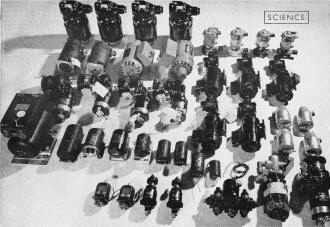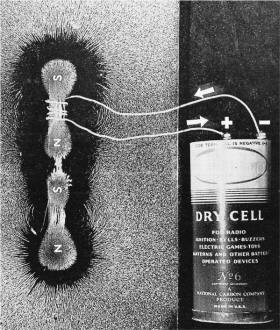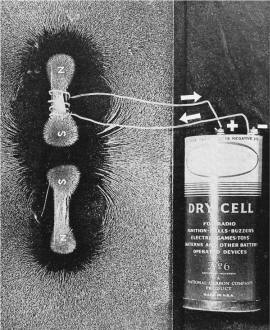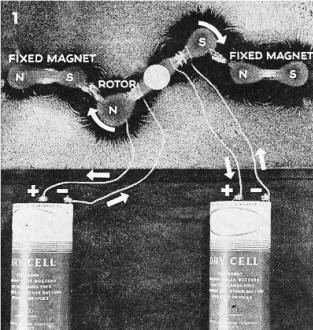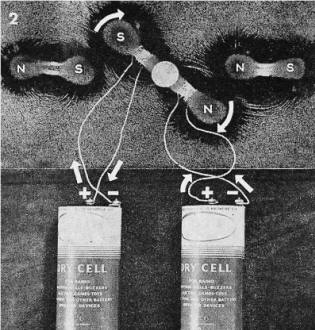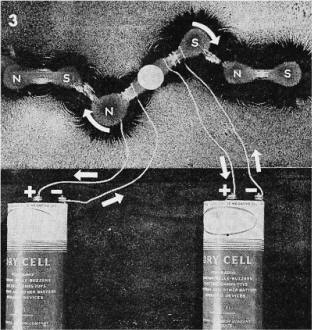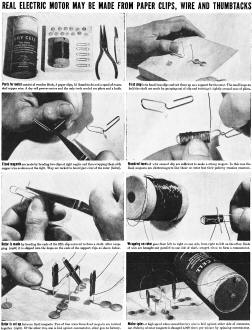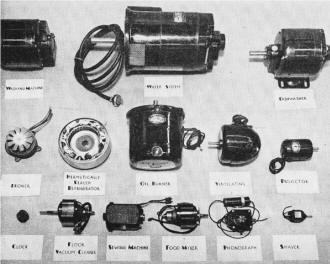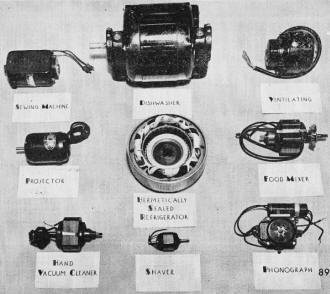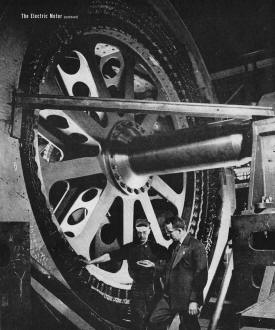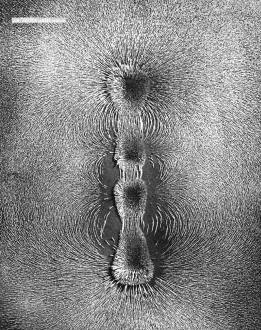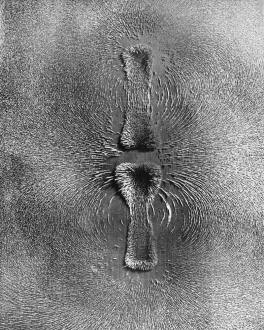The Electric Motor
|
|
Who doesn't love watching, listening to, and even smelling an electric motor at work? I've been fascinated by them since getting my first Gilbert Erector Set, or was it my first model train set, or slot car track, or a battery-powered Stanzel flying model helicopter and airplane...? Throughout my life, I have always appreciated the usefulness of electric motors, and have installed and wired many motors, as well as having taken apart and cleaned and repaired both AC motors and DC motors of many kinds. The largest motor was a 440-volt, 3-phase job for a massive air compressor, or maybe it was the concrete block forming machine in Annapolis (Gomoljack, I believe) - a very loud and vibratory process in the back day (pity the neighbors). That was in the late 1970s, and they're still in business! The smallest are probably fingernail-size motors in nano servos used in tiny model airplanes. Whether they use brushes on slip rings on commutators, induction, electromagnets or permanent magnets, they're all amazing. In 1943 when this article appeared in Life magazine, brushless motors were mostly a laboratory curiosity, but today they're the rule rather than the exception on most high energy density applications (tool, automotive, models, appliances, manufacturing). The Electric MotorBoeing Flying Fortress uses 42 electric motors to pump fuel, open and close doors, raise and lower wheels. Four large motors at top start main engines. In the U. S. some 200,000,000 electric motors run clocks, start automobiles, wash clothes, hoist elevators and pull trains. They are man's most numerous and versatile engines. Compared to the gasoline motor or the steam engine, the electric motor, with only one moving part, is wonderfully simple and efficient since it converts 90% of the energy supplied to it into useful mechanical work. This makes it three times more efficient than an automobile motor and five times as efficient as a steam engine. In addition, the electric motor is cheap to make and convenient to use. This has made it popular in industry where it powers factory machinery, replacing the old welter of overhead belts and pulleys. In its newest field of application, the air, it has almost wrested control from the pilot, lifting flaps and landing gear, and spinning the gyroscopes that guide the plane automatically on its way. The basic principle of the electric motor is contained in the attraction and repulsion between magnets. On next three pages, in demonstrations set up by the General Electric Company, LIFE shows how this magnetic force may be controlled, converted in-to rotation and put to work turning wheels and gears. Current produces attraction when it flows from top to bottom down through wire wrapped around upper magnet. Such a magnet, produced by electric current, is called an electromagnet. Current produces repulsion when its direction around magnet has been reversed by switching the wire connections at the battery. Current now flows from bottom to top around magnet. Rotor is attracted toward fixed magnets when its poles are opposite to those of fixed magnets. Note the bridge of filings.
Rotor is repelled when wires are switched, reversing polarity. Switching is done the instant rotor passes fixed magnets. Rotor completes a revolution and starts another when its poles again become opposite to those of the fixed magnets. Real Electric Motor May Be Made from Paper Clips, Wire and Thumbtacks Parts for motor consist of wooden block, 5 paper clips, 13 thumbtacks and a spool of enameled copper wire. A dry cell powers motor and the only tools needed are pliers and a knife. First step is to bend two clips and set them up as a support for the rotor. The small loops to hold the shaft are made by grasping end of clip and twisting it tightly around nose of pliers. Fixed magnets are made by bending two clips at right angles and then wrapping them with copper wire as shown at the right. They are tacked to board just clear of the rotor (below). Hundred turns of wire around clip are sufficient to make a strong magnet. In this case the fixed magnets are electromagnets like those on rotor but their polarity remains constant. Rotor is made by bending the ends of the fifth clip outward to form a shaft. After wrapping (right) it is slipped into the loops on the ends of the support clips as shown below. Wrapping on rotor goes from left to right on one side, from right to left on the other. Ends of wire are brought out parallel to one side of shaft, scraped clean to form a commutator. Rotor is set up between fixed magnets. Two of four wires from fixed magnets are twisted together (right). Of the other two, one is laid against commutator, other goes to battery. Motor spins at high speed when second battery wire is laid against other side of commutator. Polarity of rotor magnets is changed 4,000 times per minute by spinning commutator. Suburban home often contains as many as 14 motors. After the war, light, powerful motors like those used on Fortress may be installed in homes to open garage doors and run small elevators. City apartment has nine motors. Refrigerator motor (center) is entirely sealed against dust and dirt and requires no oiling or other attention during its 12- to 14-year life. Giant Electric Motor Is as Simple as a Tiny One This 10,000-h.p. motor, built by General Electric, is used to drive the biggest U. S. oil tankers. With the same general shape and the same number of essential parts, it differs only in size from the one in man's hand. It is this astonishing simplicity and range in power that makes the electric motor such a wonderful machine. Its only drawback is confining necessity of drawing electric power by wire from some other bulky mechanism. Already, however, there has been development on way to broadcast electricity through the air. When this becomes a reality the electric motor will be the universal source of mechanical power. Attraction Every magnet has two poles, north and south. In this picture a pair of bar magnets have been placed end to end beneath a piece of paper with their opposite poles (N and S) an inch apart. Iron filings, sprinkled on paper, have aligned themselves with the forces looping around and between the magnets. The pattern thus traced shows that these two magnets, with their opposite poles adjacent, are attracting each other, and would jump together if released. Repulsion In this picture the lower magnet has been reversed so that like poles (S and S) are adjacent. The two magnets are now repelling each other and have a tendency to spring apart. This is clearly shown by the fanned-out pattern of the filings and by the absence of any bridge of filings across the gap between the magnets, as in the picture on the opposite page in the electric motor this forceful attraction and repulsion between two magnets is controlled and thus made to spin the rotor. The Electric Motor Transforms Magnetic Push and Pull into Rotation When Thomas Davenport of Brandon, Vt. built the first successful electric motor in 1834 he succeeded in converting the awkward push and pull between magnets into smooth rotation. He did this by first controlling polarity of a magnet (above), then mounting it on a swivel between other magnets (below). If an electric current is sent through a wire that is wrapped around a bar of iron, the bar will become a magnet. The polarity of this magnet may be controlled (i.e., reversed at will) by changing direction of the current's flow. In the two pictures above, the poles of the top magnet have been reversed by switching the wires on the battery, thereby sending current around the magnet in the opposite direction. In an electric motor two such controllable magnets are mounted on a rotor between magnets in which the polarity remains constant. In the demonstrations 1 to 3 below, the polarity of the magnets on the rotor is switched so as first to pull them toward the fixed magnets and then push them away. With their polarity constantly alternating between attraction and repulsion, the magnets force the rotor to revolve. In a real motor the two magnets are fixed to a shaft mounted on bearings and their polarity is automatically and continually reversed by a revolving switch called a commutator. In large motors 40 or 50 magnets may be mounted on the shaft, producing great power at reduced speed.
Posted January 1, 2024 |
|

